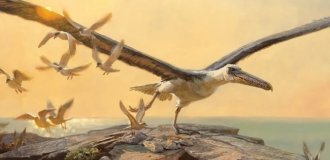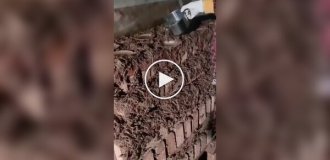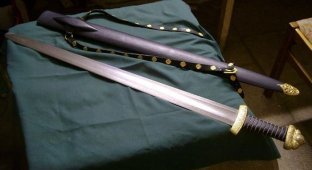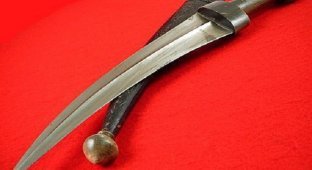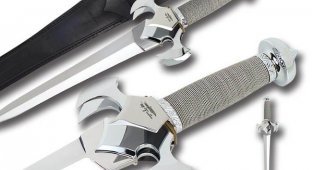Swords from "The Lord of the Rings" (36 photos)
There are many swords in this work, they are varied and woven into the narrative fabric

Elven-made blades. The film presents two varieties of them. The first is straight swords with leaf-shaped blades, positioned as examples of old elven weapons. This group includes Frodo's "Stinger" and Gandalf's "Glamdring".

Blades in the form of an elongated leaf emphasize the age of the swords - in history we find leaf-shaped blades from 1500 to 450 BC, when they were widespread. The leaf-like shape of the blade was caused by the desire to strengthen it in the central part, since blades made of bronze and iron very often bent or broke in this place.

The “sting” is just a replica of one of these swords (probably a Greek xiphos) - short, 56 centimeters in length.

In this case, we see a later handle and crosspiece than expected. The sword is intended primarily for stabbing.
Such blades are suitable for infantry operating with shields in dense formation, like the Greek phalanx. At the time when the film and book take place, this weapon is a pure anachronism for most warriors and is suitable only for a hobbit, since it replaces a full-fledged sword due to his height. But even in this case, the design of the blade is not justified in any way - it is doubtful that the “Sting” was made of bronze, and a steel blade does not need such a thickening in the middle.

Gandalf's "Glamdring" in its proportions is a classic bastard sword of medium (121 cm) length.

Perhaps this is the most unusual sword from the entire epic. Despite the fact that its design is a wild mixture of elements - the crosspiece with curved temples belongs to a small group of “Gothic” bastard swords of the 16th century, the heavy elongated metal head belongs to earlier chopping examples with heavy blades, and the leaf-shaped blade is not at all has historical parallels in that its bulge is positioned much closer to the end, the Glamdring is a fully functional and believable weapon. You can completely trust such a blade with your life.

The sword weighs quite a lot due to the leaf-shaped blade, but its large head balances it well, so it is quite suitable for fencing and holding with one hand. The widening of the blade shifted towards the end suggests excellent cutting capabilities of the blade, but at the same time reduces the penetrating power of piercing blows. The deep fuller, which gives the blade rigidity and strength, only strengthens this judgment.

Thus, we have before us a sword suitable for a wealthy knight, capable of performing well both on foot and in cavalry combat (although more so on foot than in cavalry combat due to the weighted end), quite effective in the period between 1300 and 1370 for years.

Later, plate armor appears, against which this form of blade is ineffective. Gandalf in the film is extremely lucky in that he does not have to fight with his sword against the Gondorians and Uruk-hai who are dressed exactly like this.

The second group of elven swords consists of curved saber-type blades - according to the designers, they should convey the graceful fighting style typical of elves, consisting of circular movements. Curved blades were chosen by the designers to show that elves had completely different, more elegant fighting techniques from humans. The Elven fighting style consists of circular movements, for which curved blades are best suited. The complete absence of a guard also emphasizes that the elves prefer not to take a blow “on the cross”, but rather tend to parry enemy attacks.

Arwen's Hedhafang sword is a mixture of a typically Japanese blade profile and a typically pistol-type saber handle, curved away from the blade. Such are the swords from Southeast Asia (for example, Thailand), although they are usually shorter (the length of the Hedhafang is 97 cm). But the long, unsharpened ricasso (approximately the length of the handle) has no analogues for this type of sword. This is an unusually interesting detail, apparently made for... grasping the blade with the other hand. As a result, the weapon acquires a good size for cavalry combat due to the length of the ricasso, and has the possibility of a two-handed grip, which typical cavalry sabers lack.
In terms of purpose, the Hedhafang most likely shares a niche with the Japanese katana and the Cossack saber - a fairly universal blade that has good chopping potential.

The Haldir Sword is broadly similar to the Hedhafang, but has a hilt twice as long and lacks the ricasso, making it a fairly historical Asian sword, more suitable for the infantryman than the horseman. In the realities of the film, this sword is not in great demand, since the orcs are dressed in solid cuirasses and plate armor, which this sword copes with extremely mediocrely. However, it is not completely meaningless - they are also not seen wearing full armor, and the orcish protective equipment misses cutting and slashing blows to the limbs.

Light double swords are short swords in length, but the absence of a guard and a apple makes them similar in appearance to knives. The length of the blade is approximately 56 cm with a total length of 77 cm. The handle has a curve, which makes the blade stand out from the rest. The blade has a double bend in the manner of the Latin letter S, but the second bend is hardly noticeable. The blade is flattened and polished - thanks to this, the blade is lighter, which shifts the balance towards the handle.

The "war swords" of the elves of Lórien are also a mixture of Far Eastern and Middle Eastern styles.

More precisely, this is a Japanese weapon “nagamaki” (a sword with a handle extended to the length of the blade, or a naginata with a shortened shaft) - with a blade processed to an early Middle Eastern profile with a wide fuller, and a handle head curved like a saber. In reality, such a weapon is not found, but, nevertheless, as in the case of the Glamdring, it is quite functional. Long - more than 70 cm, with a total length of the weapon of about 1.5 m - the handle is a wonderful lever that transmits great force to the wide blade. As a result, the sword (although it can more likely be classified as a kind of ax) is adapted to the most powerful chopping and cutting blows, is effective at both close and medium distances, allows strong blows with the handle, but is not suitable for thrusts.
It also has a serious drawback - the technique of using it is extremely complex and the full range of possibilities is available only with a truly professional level of proficiency.

Ordinary elves carry falchions, typical in blade and atypical in guard, or falchion - a European bladed weapon with a short blade that widens towards the end and is sharpened on one side.

The falchion became most famous as an additional weapon of English archers, which is probably why it became a weapon of the elves.

The sword of the Dwarf King Thorin “Orcrist”, that is, “Orc Gnaw”.

The sword was clearly inspired by the Greek kopis, a cousin of the xiphos, another variant of the ancient Greek sword. Its name, translated into Russian, means “to chop, to cut off.” Another name for copis (more modern and in Latin) is falcata or mahaira. And the motifs of the same falchion were used.

In contrast to the Elvish, which is a mixture of times and styles, the weapons of the warriors of Gondor are quite reliably conveyed blades from the times of the late Middle Ages. Such, for example, is the sword of Boromir.

Perhaps, only the bent arms of the crosspiece give it some historical unreliability. Otherwise, this is a typical sword of the late Middle Ages, which would look quite natural even in a museum showcase. The sword has a length of 99 cm, the blade, quite wide at the base, turns into a thin piercing edge, as a result of which it is perfect for both a slash and a lunge.
A common weapon paired with a shield and suitable for use by an infantryman rather than a horseman, such blades were ubiquitous from the 13th to the 15th centuries.
If we talk about the film, then these swords most closely correspond to the class of defensive weapons shown for most peoples - Mordorian orcs, Uruk-hai, Gondorians themselves, and elves.

This also includes Faramir's sword, although it is closer to the bastard - narrower and somewhat longer.

In general, it is similar to Boromir's sword, but is more suitable for a horseman. It is also quite historical, although it is spoiled by the shape of the headband, more typical of early swords of the 11th-12th centuries, and the bows of the cross.

The sword of Aragorn (the sword of Strider), with which he began the campaign, until he received Narsil - an unadorned bastard sword, 120 cm long, an absolutely purposeful weapon that could be worn by a simple knight or a leader of mercenaries. The 91-centimeter blade is quite narrow, reinforced with a wide fuller and equipped with a reinforced tip, an elongated pear-shaped head, a reinforcing ring on a leather-covered handle, slightly curved and thicker arms towards the ends. The sword is light enough to be used with one hand. It corresponds absolutely completely to historical analogues.
A curious feature is also the additional knife in a sheath attached to the scabbard of the sword - a custom that was in vogue among the Landsknechts and other mercenaries.

The Narsil/Andril sword is apparently the most famous weapon in the entire Ring Trilogy.
In “ancient times,” men and elves united in a final alliance against the monstrous Sauron. King Elendil of Gondor was killed by Sauron during the Battle of Mount Orodruin, his sword Narsil breaking into pieces. But with one of these pieces, Isildur - the son of Elendil - managed to cut the ring from Sauron’s hand, which overthrew his power... and the real story about the “ring” began.
During the war for the ring, Narsil is restored. The fragments of the blade are chained together, and he is, in a sense, reborn under the name "Andril" ("Flame of the West").

Tolkien himself describes "Andril" as follows: "... on its blade were engraved as a symbol seven stars between the crescent of the moon and the radiant sun, and besides there were many runes." Elsewhere "Andril" (in comparison to Boromir's sword) is described as a long sword. But this, naturally, is not very expressive: the film version of “Narsil” (total length 134 centimeters), in general, corresponds to a combat sword. The silver plated mount at the bottom is covered in leather and is meant to evoke stems and leaves. The openwork crown features an inscription in Tolkien's elven language, Quenya, and 24-karat gold overlays.

The newly forged Andril is, apart from the engraving, an exact copy of the Narsil. Here it was possible to realize Tolkien’s plan somewhat more accurately: the sun is engraved on the base of the blade, and a runic inscription is engraved on the blade, interrupted by seven stars and ending with the symbol of the month.
We must pay tribute to the group of blacksmiths who made weapons for “The Lord of the Rings” - they did everything to ensure that the weapons forged in “ancient times” were like that. Narzil/Andril (hereinafter referred to as Andril for simplicity) is a “battle sword” (German: Kampfschwert) of the 13th century, which in relation to the “modern” blades of the Gondorians really seems old. The term "battle sword" is used by German chroniclers to describe large bastard swords and early two-handed swords for infantry combat. Andril himself is 134 cm long, is carried by Aragorn (which is completely historically correct) at the saddle and, in my opinion, is still closer to a two-handed sword, despite the blade being quite characteristic of a bastard. The sword is heavy, chopping, although it has a reinforced edge, adapted for a strong thrust. Accordingly, the head of the sword is also quite weighted and its elongated part occupies half of the handle (which, again, is more typical for bastards). But the very wide arms of the cross with extensions are more likely from a two-handed sword.

Theoden's sword - Herugrim is very typical for a Sarmatian or even Scythian horseman. Rohan is stylized as a very early Middle Ages - the Franks or an earlier time of the Sarmatians. They are characterized by the “scaled armor” of the king’s bodyguards, which is characteristic of cataphracts (cataphracts), which irritates many film critics. The swords are also brought into line and the entire complex of offensive-defensive weapons speaks of backwardness in comparison with the weapons of those around them, which are thousands of years removed.

This is a typical spatha, a fairly heavy one-handed weapon for a horseman, intended for a slashing blow, which lasted from the Scythians through the Iranians to the Romans for a thousand years.

Eowyn's sword stands out somewhat.

Firstly, it has a reinforced tip for pricking, which is not the case with early spathas. In general, his blade profile is closer to the late medieval one. And secondly, it has a very funny head in the shape of a “mushroom cap,” as it is called in weapons science, characteristic of swords of the Carolingian and Merovingian types (“Viking swords”), intended for combat on foot with a shield, and not for mounted southerners. However, the purpose in the film is a horse-drawn cabin.

The black swords of the Nazgul are also of the "war sword" type, eight of them are armed with the blades shown in the picture.
Length about 130 cm, wide arms, reinforcing ring on the handle. The head is a rather strange, faceted type. The blades of the swords are clearly from the late Middle Ages - they do not have a fuller, but an edge, a reinforced end for a thrust. The most interesting part is the asymmetrical blade - there is no historical prototype for it, but nevertheless it is quite real. Personally, the thickening of the sword at the hilt makes me think that it would be nice for the Nazgul to use “half-sword” techniques, when one hand rests on the blade. The thickening also provides some support, and allows you to fearlessly expose the area of the sword between your hands to blows, without fear that the blade will not withstand. And at the same time it is convenient to operate the lighter front part.

The sword of the Witch King differs from the other eight.
In terms of its layout, it is a classic Danish bastard sword of the late Middle Ages. There are curved arms of the cross, and a reinforcing tube on the handle, and an unsharpened ricasso in front of it, and an extension of the blade above the ricasso, and characteristic proportions - the sword has a total length of 139 cm, of which 38 are on the handle. The blade with an edge is suitable for both thrusting and powerful chopping due to the long lever of the handle. Actions on foot are also possible as a kind of short spear, then one hand moves to the ricasso, and the other to the end of the handle.

And sometimes it still burns.

The production of all these wonderful swords was carried out by the blacksmith Peter Lyon, who sifted all the design creativity through a rigid sieve of maximum functionality.
“Whatever the designers’ idea,” he said, “no matter what bells and whistles their imagination gives birth to, I always try to make the sword as reliable as possible as a weapon. And the main criterion here is the proportions of the weapon, its details.
Artist John Howe worked with Lyon on the film's props. He headed the work of an entire department, on whose shoulders lay the creation of the artistic concept of the film.
It is worth mentioning an interesting detail - Howe is engaged in the historical reconstruction of Medieval Europe, and is a member of one of the most serious associations with a worldwide reputation - the “Company of St. George”.
So the film was lucky: both the blacksmith and the chief designer put the historical accuracy of the film weapons at the forefront.
The work was carried out like this. At first, designers came up with sketches and made life-size cardboard models of weapons. They were then passed on to Peter Lyon, who discussed them with Howe and the rest of the group. Peter then proceeded to make them.
“All the blades that were shown to the viewer in close-up were made of spring steel, so if they were sharpened, I would trust them with my life,” Lyon said and added. that the weapon was specially “aged” so that it looked natural. This is quite consistent with the idea of The Hobbit director Peter Jackson:
“I had one goal: I wanted to immerse audiences in the fantasy world of Middle-earth in an authentic and compelling way.”

